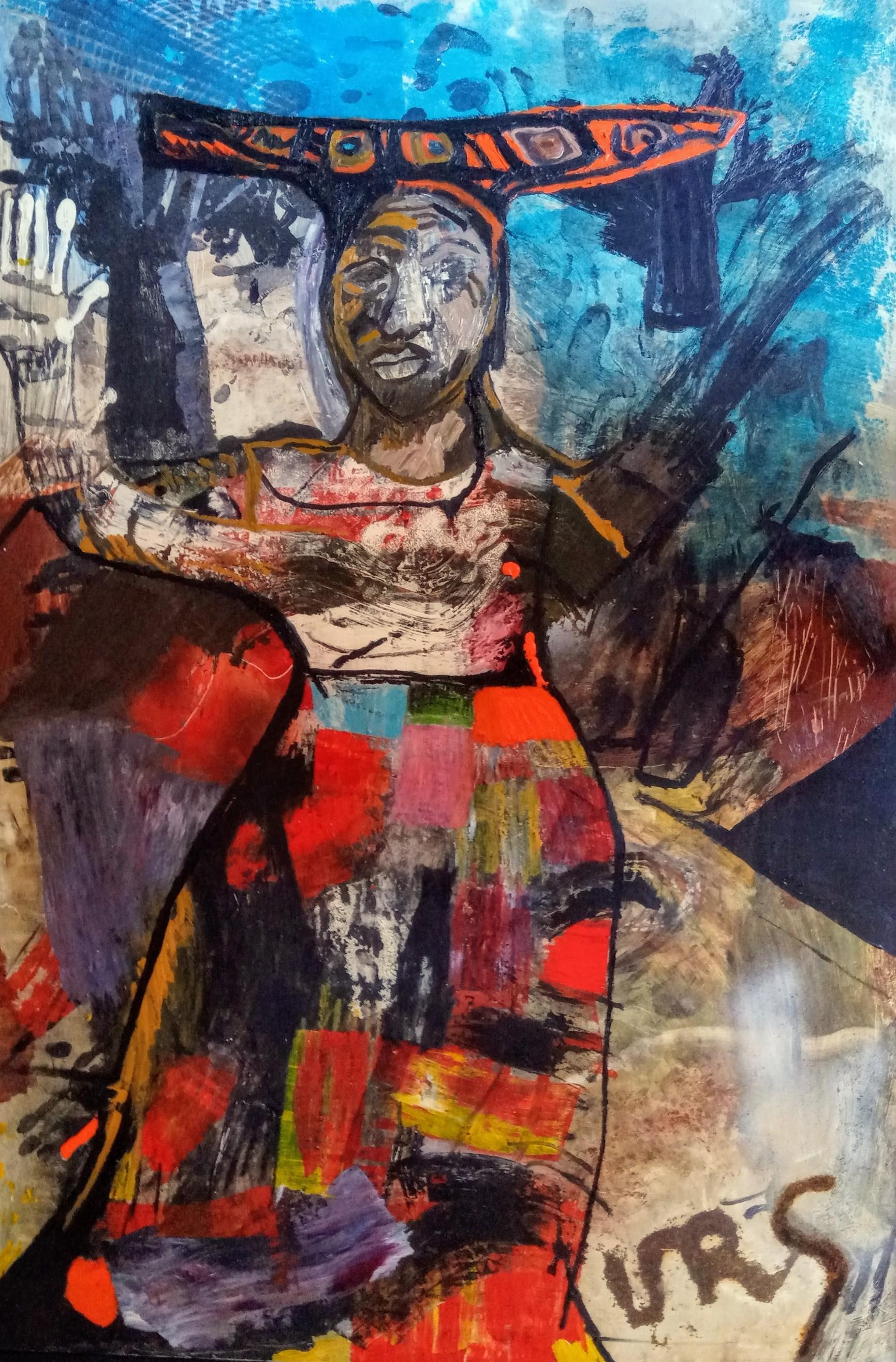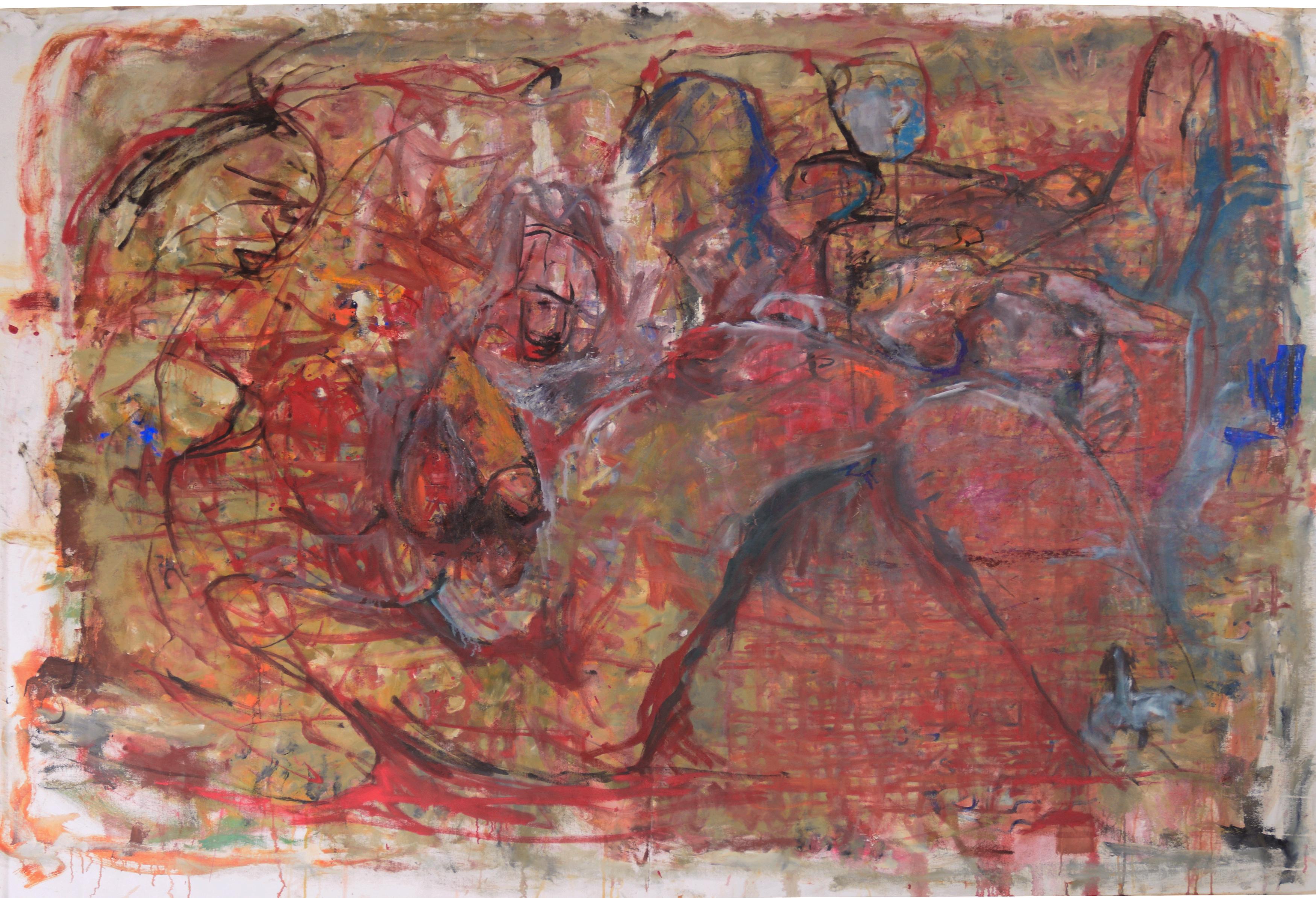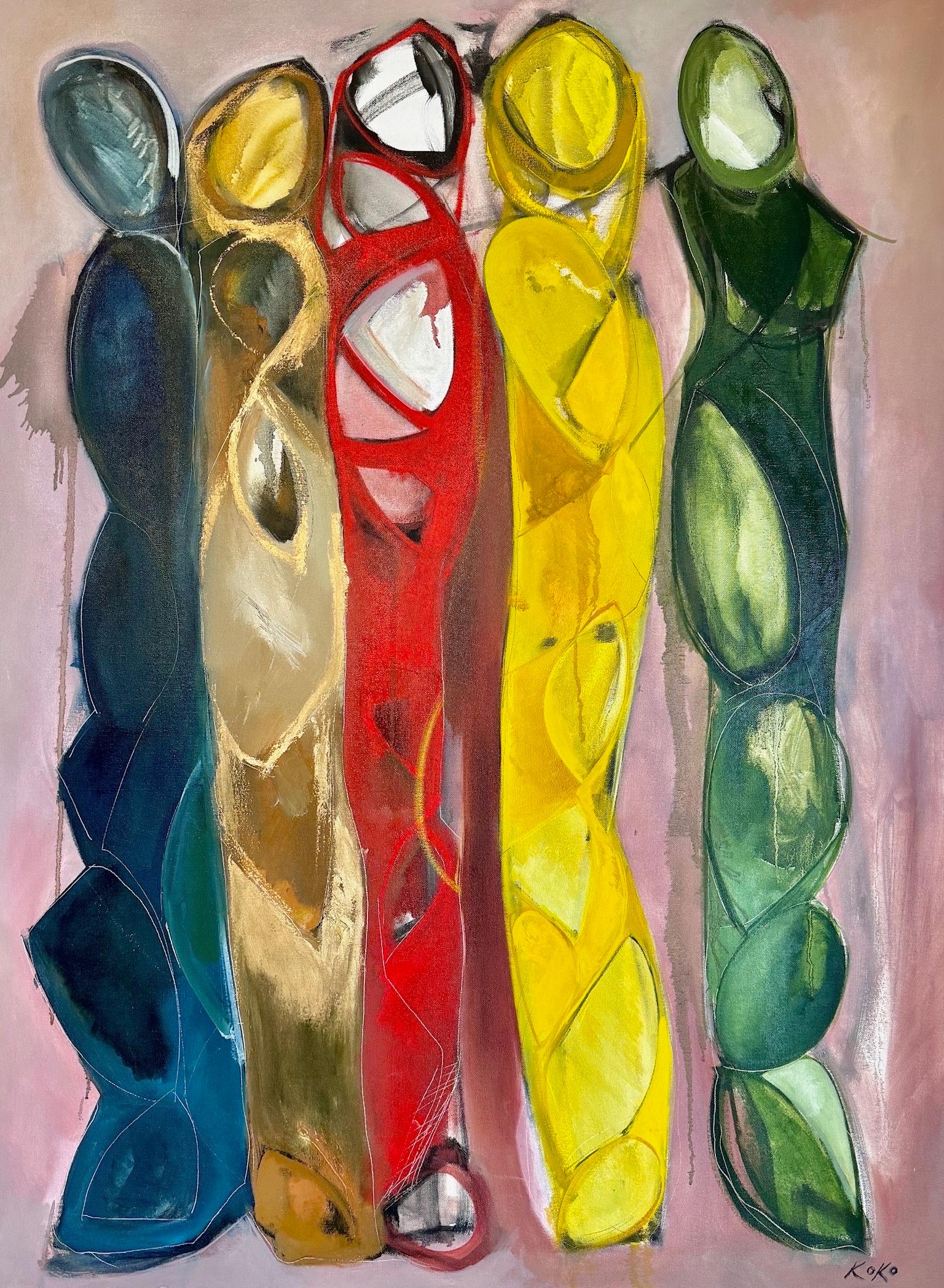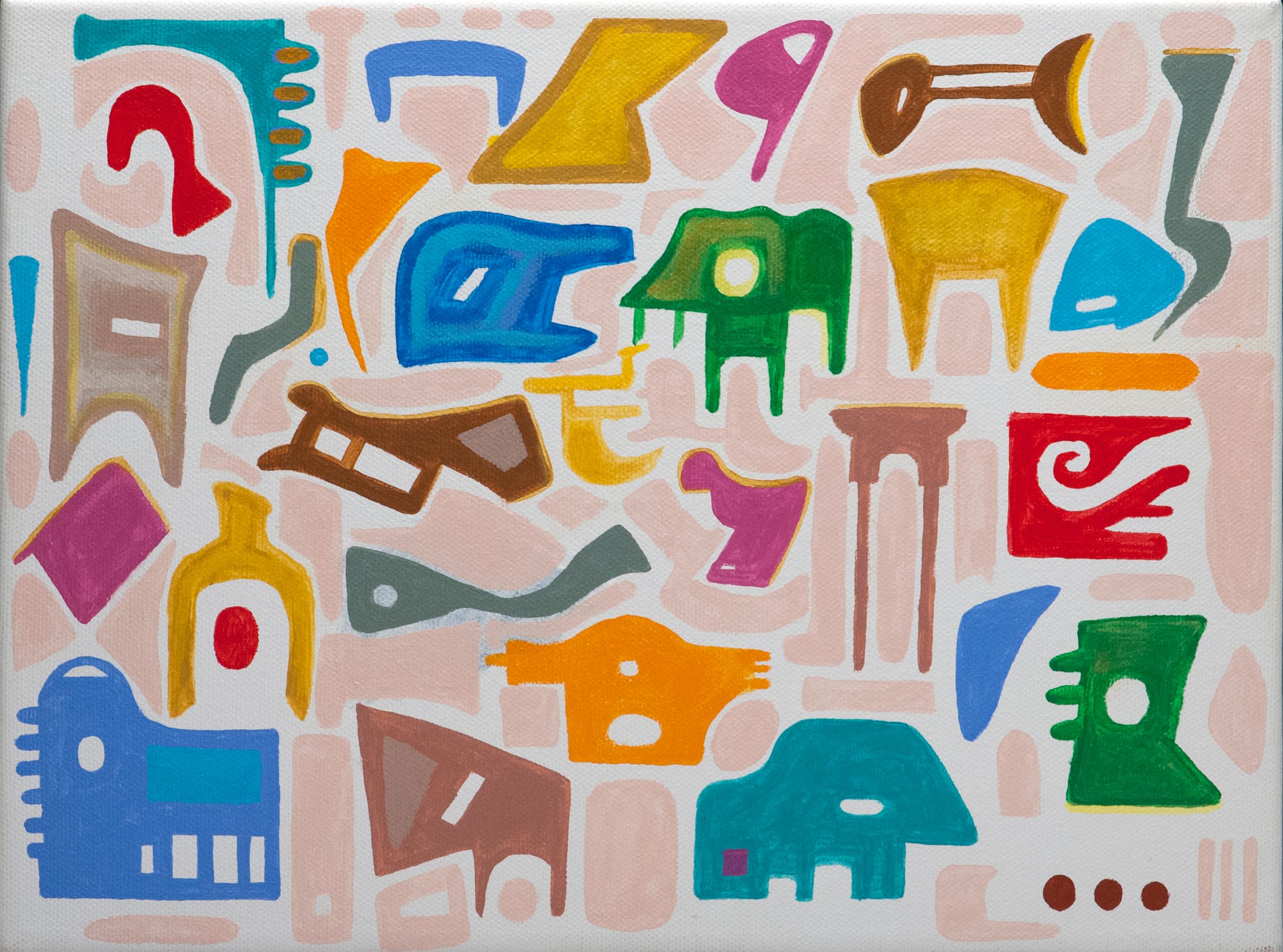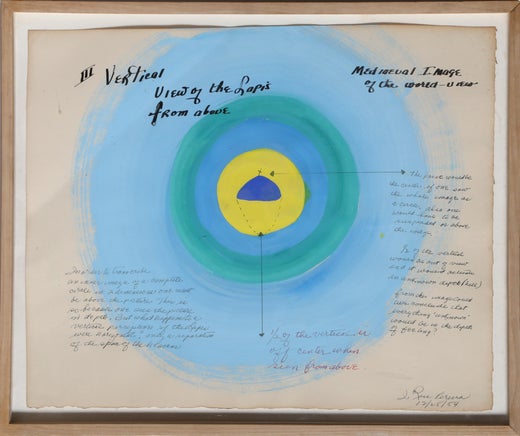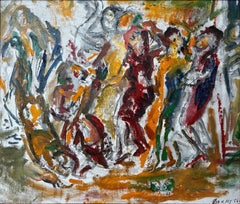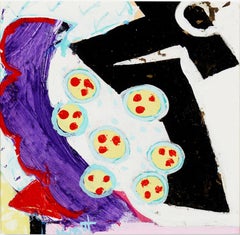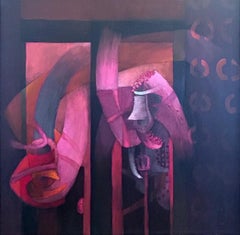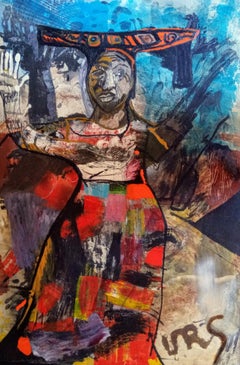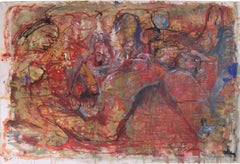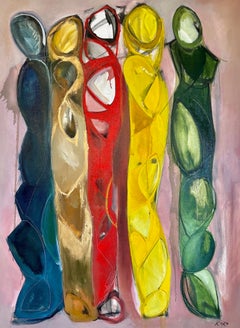Items Similar to "Composition with Figure, " Irene Rice Pereira
Want more images or videos?
Request additional images or videos from the seller
1 of 8
Irene Rice Pereira"Composition with Figure, " Irene Rice Pereira1951
1951
$3,000
£2,262.30
€2,616.46
CA$4,208.98
A$4,678.55
CHF 2,452.39
MX$57,136.38
NOK 30,616.73
SEK 28,804.63
DKK 19,528.47
About the Item
Irene Rice Pereira
Composition with Figure, 1951
Inscribed, signed and dated Salford/Pereira 2/51 (lr); inscribed I Rice Pereira/2669 Great Clowes St/Salford 7 Manchester/after May 15/121 W 15 St, New York, 11, NY on a paper label affixed to the verso
Casein tempera and India Ink on paper
13 1/4 x 20 1/4 inches
Considered the most avid Bauhaus proponent in the United States during the 1930's and 40's, Irene Rice Pereira's oeuvre reflects her commitment to machine-age materials and a philosophy that called for a merging of technology and the transcendental. (Smithsonian Archives) Her works emphasize the importance of light, space and its continuum; ideas inherent throughout Pereira's entire oeuvre.
Pereira's industrial-influenced works of the early 30's clearly recall Sheeler and Demuth, with their focal point on man versus the machine age, while also reflecting tendencies seen in the work of Leger, with bright, bold, flat color planes outlined by thick, black, contoured lines.
As a founding member of the Design Laboratory in New York, an environment which encouraged experimentation with all art forms and mediums, Pereira developed her most intricate qualities of dimension in her glass works beginning in 1939. The illusionistic three-dimensional quality of these created a responsive and independent movement between light and color; a transcendence of space. These compositions are rare and highly sought after.
Yet, Pereira's works from the 1950's and 1960's are thought to be her most comprehensive and successful attempts at creating works which were both technically satisfying and philosophically transcendental. These works represent Pereira's newly developed vocabulary, one in which philosophy and geometric symbolism was used in place of visually interpretable objects.
In addition to her work with the Design Laboratory, Pereira was also an early member of the American Abstract Artist's, a group dedicated to the promotion of abstract art and was awarded retrospectives at the Museum of Modern Art in 1946 and The Whitney in 1953. Her work is included in the permanent collections of a number of museums including the Metropolitan, Smithsonian, Guggenheim and Whitney.
Irene Rice Pereira
Born Irene Rice, she took the name of her first husband, the commercial artist Umberto Pereira. She adopted the name I. Rice Pereira because then as now discrimination beset women in the arts. By the time war broke out Irene had divorced Pereira and married George Wellington Brown, a marine engineer from a prominent Boston family. Brown was an ingenious experimenter with materials, and he encouraged his petite new wife in their mutual passion for experimentation. Pereira in the 1930s was drawn to ships, not only because of George Brown, but because of their intricate machinery, their functional beauty. The inside-out infrastructure of the Pompidou museum in Paris amused Pereira, although she thought it art-historically tardy. Irene Rice Pereira was a lovely, fragile being. Her presence was hushed. She spoke almost in a whisper and listened far more than she spoke. She was a prodigious autodidact and a spellbinding lecturer. The main body of her metaphysical library today resides in the Museum for Women in the Arts in Washington, D.C. Her papers and the manuscript for her still unpublished book, Eastward Journey, are available to scholars in the Schlesinger Library at Harvard. Pereira won recognition for her abstract geometric work, particularly her jewel-like works on fluted and coruscated layers of glass, throughout the 1940s and early 1950s. In 1953 the Whitney Museum, then in Greenwich Village, gave her a retrospective exhibition with Loren MacIver, and that same year Life magazine published a centerfold photo examination of her work. By the late 1950s Abstract Expressionism had swept Manhattan, flattening such nascent movements as Geometric Abstraction. Such artists as Stuart Davis, Stanton MacDonald Wright, George L.K. Morris, George Ault, Jan Matulka, Richard Leahy, Philip Guston and many others were eclipsed. Pereira believed that a European angst, brought to our shores in the wake of the Holocaust, had introduced a cynicism and a profoundly anti-female sensibility that boded ill for art in America. Rightly she pointed out that even when the works of women were acquired by museums they were rarely shown, a disgrace that persists to this day. The women who did achieve success, she said, were often collaborators with more famous male artists and tastemakers. Pereira died in 1971 in Marbella, Spain, ill and broken-hearted. She had been evicted from the Fifteenth Street studio in Chelsea where she had painted for more than thirty years. Suffering from severe emphysema, she could barely negotiate a few stairs. But by the 1980s a new generation of women scholars and curators had begun to resurrect her stature. A considerable following has formed to honor a pioneer artist who cared about other artists and willingly paid the price to denounce what others feared in silence. Indeed when Pereira sold a painting she had two immediate impulses: buy a new hat, and give the money to an artist friend in trouble. She loved hats but loved to help fellow artists even more.
About the Seller
5.0
Platinum Seller
Premium sellers with a 4.7+ rating and 24-hour response times
Established in 2022
1stDibs seller since 2022
120 sales on 1stDibs
Typical response time: 1 hour
- ShippingRetrieving quote...Shipping from: New York, NY
- Return Policy
Authenticity Guarantee
In the unlikely event there’s an issue with an item’s authenticity, contact us within 1 year for a full refund. DetailsMoney-Back Guarantee
If your item is not as described, is damaged in transit, or does not arrive, contact us within 7 days for a full refund. Details24-Hour Cancellation
You have a 24-hour grace period in which to reconsider your purchase, with no questions asked.Vetted Professional Sellers
Our world-class sellers must adhere to strict standards for service and quality, maintaining the integrity of our listings.Price-Match Guarantee
If you find that a seller listed the same item for a lower price elsewhere, we’ll match it.Trusted Global Delivery
Our best-in-class carrier network provides specialized shipping options worldwide, including custom delivery.More From This Seller
View All"Untitled" Theresa Bernstein, Expressionist Work by American Ashcan Artist
By Theresa Bernstein
Located in New York, NY
Theresa Bernstein
Untitled, circa 1990
Signed lower right
Oil on canvas
16 x 20 inches
Theresa F. Bernstein was born in Philadelphia in 1895 to cultured, middle-class immigrant par...
Category
1990s Abstract Abstract Paintings
Materials
Canvas, Oil
"Untitled" Knox Martin, Abstract Expressionism, Purple, Yellow, Black
By Knox Martin
Located in New York, NY
Knox Martin (1923 - 2022)
Untitled
Signed to lower edge
Acrylic and gold foil on canvas
9 x 9 inches
Knox Martin (1923-2022) was an esteemed New York School painter. Knox Martin was born in 1923 in Barranquilla, Colombia. He was the son of the aviator, painter, and poet William Knox Martin, the first man to fly over the Andes Mountains.
After serving in World War II, Knox Martin attended the Art Students League of New York on the G.I. Bill from 1946-1950, where he studied with Harry Sternberg, Vaclav Vytlacil, Will Barnet, and Morris Kantor.
In 1954, Knox Martin's friend Franz Kline placed a painting of his in the Stable Gallery Annual. Charles Egan of the renowned Charles Egan Gallery saw Knox Martin's painting at the Stable Gallery and asked Martin to show his work in a one-man show for the tenth anniversary of the Egan Gallery.
Since then, Knox Martin was a celebrated painter, sculptor and muralist. Knox Martin had an extensive exhibition record and his work is in museum, corporate and private collections worldwide. His two best-known murals in NYC are Venus and Woman with Bicycle...
Category
Late 20th Century Abstract Abstract Paintings
Materials
Gold, Foil
"El Innombrable" Fernando de Szyszlo, Red Mysticist Abstract Composition
By Fernando de Szyszlo
Located in New York, NY
Fernando de Szyszlo
El Innombrable, 1980
Titled inscribed dated verso: Orrentia 1980 "El Innombrable"
Signed lower bottom edge center "Szyszlo"
Oil on canvas
59 1/2 x 59 inches
Fernando de Szyszlo was a Peruvian painter...
Category
1980s Surrealist Abstract Paintings
Materials
Canvas, Oil
"Untitled, " Sebastian Gross-Ossa, Contemporary Figurative Painting
Located in New York, NY
Sebastian Gross-Ossa (American, b. 1966)
Untitled, 2000
Oil on canvas
14 1/8 x 11 inches
Signed and dated on the reverse
Category
Early 2000s Contemporary Figurative Paintings
Materials
Oil, Canvas
$3,200 Sale Price
20% Off
"Untitled, " Daniel Lergon, German Contemporary Abstract Painting
Located in New York, NY
Daniel Lergon (German, b. 1978)
Untitled, 2012
Oil on canvas
47 1/2 x 39 1/2 inches
Signed and dated on the reverse
Provenance:
Galerie Christian Lether...
Category
2010s Contemporary Abstract Paintings
Materials
Canvas, Oil
"Untitled" Lawrence Philp, Abstracted Surrealist Forms by Afro-American Artist
Located in New York, NY
Lawrence Philp
Untitled
Oil and acrylic on canvas
75 1/2 x 79 inches
Lawrence Philp, the son of Jamaican immigrants, studied at the Rhode Island School of Design and was included i...
Category
1970s Post-Modern Abstract Paintings
Materials
Canvas, Oil, Acrylic
You May Also Like
German Contemporary Art by Ursula Krauss - Memme
By Ursula Krauss
Located in Paris, IDF
Oil on board, frame included
Category
2010s Abstract Abstract Paintings
Materials
Oil, Board
German Contemporary Art by Ursula Krauss - Dreamdancer
By Ursula Krauss
Located in Paris, IDF
Oil on canvas
Category
2010s Abstract Abstract Paintings
Materials
Canvas, Oil
Large Scale Neo-Expressionist Figurative
By Daniel David Fuentes
Located in Soquel, CA
Compelling and large scale neo-expressionist figurative painting by San Jose, California area artist Daniel David Fuentes (American, 20th century), Circa 1995. Unsigned. From a colle...
Category
1990s Neo-Expressionist Abstract Paintings
Materials
Canvas, Oil
Contemporary figures, Vignettes, Abstract figures.
Located in La Canada Flintridge, CA
it is oil on canvas and artist Koko sighed lower right.
Category
2010s Abstract Expressionist Figurative Paintings
Materials
Oil
Psicodélico, Contemporary Art, Abstract Painting, 21st Century
By Enrique Pichardo
Located in Mexico City, MX
Contemporary Art, Abstract Painting
Acrylic on canvas
160 x 190 cm
Signed
FREE SHIPPING ROLLED UP
About the artist
Enrique Pichardo (Mexico City, 1973) graduated from Escuela Nacio...
Category
2010s Abstract Abstract Paintings
Materials
Canvas, Acrylic
"Archetypes" Abstract Modern Painting
Located in Washington, DC
Appealing painting by Brazilian-born artist Elizabeth Freire. Work is acrylic on canvas. Signed on reverse and titled "Archetypes". B&W photo is of Ms. Freire with renowned sculptor Etienne Martin...
Category
2010s Abstract Abstract Paintings
Materials
Acrylic, Canvas
$1,400 Sale Price
20% Off
More Ways To Browse
Rice Paper Vintage
1930s Industrial Painting
St Leger
Irene Brown
Cuban Artists Painting
The Phillips Collection
John Grant
Painted Canvas Tapestry
Paintings Of Shells
Fragment Oil Painting
Pair Of Abstract Paintings
Rose De France
Spirit Of Freedom
Paintings By Simon
French Expressionism
Modern Industrial Paintings
Abstract Coastal Art
Love House Ny
